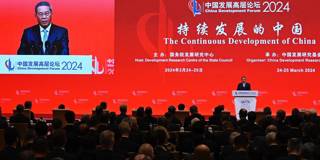While China obviously needs to boost private-sector confidence and revive growth with a more sustainable economic model, it is not clear that Chinese leaders fully appreciate the challenges they face. The shift back to state capitalism over the last decade is plainly incompatible with President Xi Jinping’s development goals.
NEW YORK – At this year’s China Development Forum (the highest-level annual meeting between senior Chinese policymakers and top CEOs, current and former policymakers, and academics like me), the discussion focused squarely on the risk of China falling into the dreaded “middle-income trap.” After all, few emerging economies have successfully joined the ranks of high-income countries.
Will China be an exception to this pattern? Following 30-plus years in which China achieved annual growth rates close to 10%, its economy has slowed sharply this decade. Even last year, with the strong rebound from the “zero-COVID” era, officially measured growth was only 5.2%. Worse, the International Monetary Fund estimates that China’s growth will fall to 3.4% per year by 2028, and, given its current policies, many analysts expect its potential growth rate to be only 3% by the end of this decade. If that happens, China will indeed find itself in the middle-income trap.
Moreover, China’s problems are structural, rather than cyclical. Among other factors, its slowdown is due to rapid aging, a busted real-estate bubble, a massive overhang of private and public debt (now close to 300% of GDP), and a shift from market-oriented reforms back toward state capitalism. Credit-fueled investment has grown excessive as state-owned banks lend to state-owned enterprises (SOEs) and local governments. At the same time, the government has been bashing the tech sector and other private enterprises, eroding business confidence and private investment.

NEW YORK – At this year’s China Development Forum (the highest-level annual meeting between senior Chinese policymakers and top CEOs, current and former policymakers, and academics like me), the discussion focused squarely on the risk of China falling into the dreaded “middle-income trap.” After all, few emerging economies have successfully joined the ranks of high-income countries.
Will China be an exception to this pattern? Following 30-plus years in which China achieved annual growth rates close to 10%, its economy has slowed sharply this decade. Even last year, with the strong rebound from the “zero-COVID” era, officially measured growth was only 5.2%. Worse, the International Monetary Fund estimates that China’s growth will fall to 3.4% per year by 2028, and, given its current policies, many analysts expect its potential growth rate to be only 3% by the end of this decade. If that happens, China will indeed find itself in the middle-income trap.
Moreover, China’s problems are structural, rather than cyclical. Among other factors, its slowdown is due to rapid aging, a busted real-estate bubble, a massive overhang of private and public debt (now close to 300% of GDP), and a shift from market-oriented reforms back toward state capitalism. Credit-fueled investment has grown excessive as state-owned banks lend to state-owned enterprises (SOEs) and local governments. At the same time, the government has been bashing the tech sector and other private enterprises, eroding business confidence and private investment.